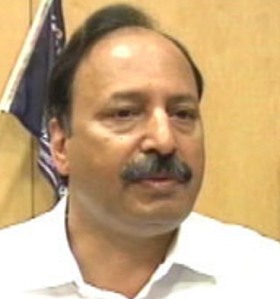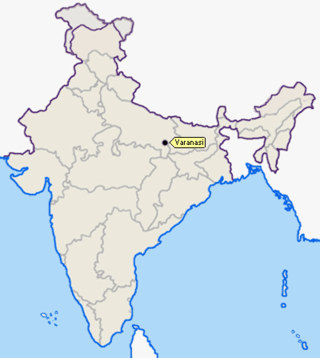The Students' Islamic Movement of India is an Indian Islamic organisation that was formed in Aligarh, Uttar Pradesh in April 1977.

The 2005 Delhi bombings occurred on 29 October 2005 in Delhi, India, killing 62 people and injuring at least 210 others in three explosions. The bombings came only two days before the important festival of Diwali, which is celebrated by Hindus, Sikhs, and Jains. The bombs were triggered in two markets in central and south Delhi and in a bus south of the city. The Pakistani Islamist terrorist group Lashkar-e-Taiba claimed responsibility for the attacks under the pseudonym of Islamic Inquilab Mahaz. The Indian Mujahideen is also suspected of involvement.

The 2006 Mumbai train bombings were a series of seven bomb blasts on 11 July. They took place over a period of 11 minutes on the Suburban Railway in Mumbai, the capital of the Indian state of Maharashtra and the nation's financial capital. The bombs were set off in pressure cookers on trains plying on the Western Line Suburban Section of the Mumbai Division of Western Railway. The blasts killed 209 people and injured over 700 more.
The 2006 Malegaon bombings took place on 8 September 2006 in Malegaon, a town in the Nashik district of the Indian state of Maharashtra, some 290 km northeast of Mumbai. The Maharashtra Anti-Terrorism Squad (ATS) initially blamed the bombings on the Students Islamic Movement of India (SIMI), but in a chargesheet filed in 2013 the NIA and ATS joint investigation and involved evidences pointed towards the involvement of eight members of jihadi extremist group claiming to be from Abhinav Bharat, who were later released from charges due to lack of evidence.
The 2007 Samjhauta Express bombing was a terrorist attack that occurred around midnight on 18 February 2007 on the Samjhauta Express, a twice-weekly train service connecting Delhi, India, and Lahore, Pakistan. Bombs were set off in two carriages, both filled with passengers, just after the train passed Diwana near the Indian city of Panipat, 80 kilometres (50 mi) north of New Delhi. 70 people were killed in the ensuing fire and dozens more were injured. Of the 70 fatalities, most were Pakistani civilians. The victims also included some Indian civilians and three railway policemen.
A blast occurred on 18 May 2007 inside the Mecca Masjid, a mosque located in the old city area of Hyderabad, capital of the Indian state of Telangana located very close to Charminar. The blast was caused by a cellphone-triggered pipe bomb placed near the site designated for ablution. Two further live IEDs were found and defused by the police. Sixteen people were reported dead in the immediate aftermath, of whom five were killed by the police firing after the incident while trying to quell the mob angered by what they considered police failure to protect the Muslims during their worship.
The Hyderabad bombings refers to the incident in which two bombs exploded almost simultaneously on 25 August 2007 in Hyderabad, capital of the Indian state of Andhra Pradesh. The first bomb exploded in Lumbini Amusement Park at 19:45 hrs IST. The second bomb exploded five minutes later at 19:50 in Gokul Chat Bhandar in Koti, a popular restaurant about 5 kilometres (3 mi) away. At least 42 people were reported to have died in the two bombings. Two more bombs were defused in other parts of the city. According to initial reports, the banned Harkat-ul-Jihad-al-Islami militant outfit of Bangladesh is suspected for the serial blasts.
2008 Bangalore serial blasts occurred on 25 July 2008 in Bangalore, India. A series of nine bombs exploded in which 1 person was killed and 20 injured. According to the Bangalore City Police, the blasts were caused by low-intensity crude bombs triggered by timers.
The 2008 Ahmedabad bombings were a series of 21 bomb blasts that hit Ahmedabad, India, on 26 July 2008, within a span of 70 minutes. Fifty-six people were killed and over 200 people were injured. Ahmedabad is the cultural and commercial heart of Gujarat state and a large part of western India. The blasts were considered to be of low intensity and were similar to the Bangalore blasts, Karnataka which occurred the day before. This bombings were done by Pakistani Islamic Terrorist group Harkat-ul-Jihad al-Islami.
The 13 September 2008 Delhi bombings were a series of five synchronised bomb blasts that took place within the span of a few minutes on Saturday, 13 September 2008 at various locations in Delhi, India. The first bomb exploded at 18:07 IST, and four other blasts followed in succession, with at least 20 people killed and over 90 injured.
On 29 September 2008 three bombs exploded in the states of Gujarat and Maharashtra of India killing 10 people and injuring 80. Two bombs went off in Malegaon, Maharashtra, which killed nine people while another blast in Modasa, Gujarat resulted in the death of one person.
The history of Mumbai during the 21st century covers the Indian city of Mumbai in the 21st century.
Abhinav Bharat is a Hindutva organization founded by retired Indian Army Major Ramesh Upadhyay in 2006 in Pune, India. It has a large base in Madhya Pradesh. The organization is believed to be the revived form of the pre-Independence era Abhinav Bharat Society. The activities of the organisations received widespread attention after Maharashtra Anti Terrorist Squad (ATS) arrested its member for the 2006 Malegaon bombings case. It has no relationship to the Mumbai-based charitable trust of the same name.

Hemant Kamlakar Karkare, was the chief of the Mumbai Anti-Terrorism Squad (ATS). He was killed in action during the 2008 Mumbai attacks. In 2009, he was posthumously given the Ashoka Chakra, India's highest peacetime gallantry decoration.
Hindu terrorism, sometimes called Hindutva terror or, metonymically, saffron terror, refer to terrorist acts carried out on the basis of motivations in broad association with Hindu nationalism or Hindutva.
The Batla House encounter case was an armed Delhi Police operation to arrest terrorists of the terrorist outfit called 'Indian Mujahideen' (IM), hiding in a flat in the Batla House area of Jamia Nagar, Okhla, on 19 September 2008. The operation resulted in the deaths of two terrorists and one police officer, Inspector Mohan Chand Sharma, with the remaining terrorists arrested. On 15 March 2021, one of the arrested Ariz Khan alias Junaid, was sentenced to death for the murder of Inspector Sharma.

The 2010 Varanasi bombing was a blast that occurred on 7 December 2010, in one of the holiest Hindu cities, Varanasi. The explosion occurred at Sheetla Ghat, adjacent to the main Dashashwamedh Ghat, where the sunset aarti, the evening prayer ritual to the holy river, Ganges had commenced, on these stone steps leading to it, where thousands of worshipers and tourists had gathered. It killed a two-year-old girl, sitting on her mother's lap, the mother was one of three critically injured, more than 38 other people were injured. In the ensuing panic after the blast, a railing broke causing a stampede leading to an increase in the number of injuries. The bomb was hidden inside a milk container on the Sheetla Ghat. The blast occurred a day after the anniversary of the 1992 Babri Masjid demolition, in which a mosque was demolished at Ayodhya leading to nationwide religious riots killing over 2,000 people. Subsequently, the Islamist militant group, Indian Mujahideen, claimed responsibility of the blast, via email to Indian media. This is also the second terrorism-related incident in the city which was rocked by the serial blasts of 2006, in which 28 people were killed, it included an explosion at the Sankatmochan Temple, some two kilometres away.

The 2011 Mumbai bombings, also known as 13/7, were a series of three coordinated bomb explosions at different locations in Mumbai, India, on 13 July 2011 between 18:54 and 19:06 IST. The blasts occurred at the Opera House, at Zaveri Bazaar and at Dadar West localities, leaving 26 killed and 130 injured. Indian Mujahideen is believed to have carried out the attack with the personal involvement of its co-founder Yasin Bhatkal.

On 7 July 2013 a series of ten bombs exploded in and around the Mahabodhi Temple complex, a UNESCO World Heritage Site in Bodh Gaya, India. Five people, including two Buddhist monks, were injured by the blasts. Three other devices were defused by bomb-disposal squads at a number of locations in Gaya.
Pragya Singh Thakur, better known as SadhviPragya, is an Indian politician and former Member of Parliament who represented Bhopal and belongs to the Bharatiya Janata Party. During her college days, she was an active member of Akhil Bharatiya Vidyarthi Parishad (ABVP) and later joined various affiliate organisations of the Rashtriya Swayamsevak Sangh (RSS).






